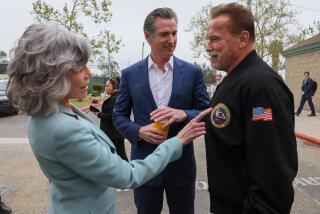Brown releases proposed rules for fracking
SACRAMENTO — The Brown administration has released much-anticipated proposed rules for fracking, a controversial technique for drilling for oil and natural gas reviled by environmentalists.
The process, formally known as hydraulic fracturing, involves pumping water, sand and a mixture of chemicals into geological strata to free trapped hydrocarbons.
Supporters say that it is opening up a vast new energy source and creating high-paying jobs. Opponents contend that fracking could pollute underground drinking water supplies and cause health hazards.
Hailed by state officials as the toughest in the nation, the draft regulations issued Friday would require those who conduct fracking to get state permits, test groundwater quality and notify neighbors before starting work. The regulations cover fracking and related techniques, and they provide substantial new public information about where and how fracking is taking place.
“We believe that once these proposed regulations go into effect at the start of 2015, we will have in place the strongest environmental and public health protections of any oil- and gas-producing state in the nation, while also ensuring that a key element in California’s economy can maintain its productivity,” said Mark Nechodom, director of the state Department of Conservation.
California is the country’s third-largest oil- and gas-producing state.
Environmentalists contend that fracking could pollute drinking water wells, endanger public health and release greenhouse gases that contribute to global warming.
What’s needed now, they said, is a statewide ban on fracking and related techniques until scientists can provide firm assurances that the practice won’t cause harm.
“We want a timeout,” said Kathryn Phillips, state director of the Sierra Club. “At best, these regulations can be described as a mixed bag,” she said. “At worst, they provide another example of an agency’s continued deference to a regulated entity, even at the expense of public health and the environment.”
Nevertheless, even some opponents conceded that the proposed regulations were better than nothing.
“There are some good provisions from our very preliminary review,” said Bill Allayaud of the Environmental Working Group.
Friday’s proposed regulations were in response to a state law approved by the Legislature this year. In addition, the new law — by Sen. Fran Pavley (D-Agoura Hills) — mandates that the state conduct an independent scientific study of the pros and cons of fracking.
The oil industry fought regulations in the Legislature, but fracking proponents say that they are comfortable with Friday’s proposal.
“These regulations are extensive but strike the right balance,” said Catherine Reheis-Boyd, president of the Western States Petroleum Assn., a trade group. They “will ensure that the potential energy resources contained in the Monterey Shale formation can be responsibly developed.”
Fracking, the oil industry and business groups counter, could be a bonanza.
They cite studies that estimate that fracking could spur the recovery of 14 billion barrels of oil locked deep underground in the Monterey Shale Formation, stretching from the Central Coast to the southern San Joaquin Valley. It also could create 2.8 million jobs and $25 billion in additional state and local government revenues.
The Department of Conservation, officials said, plans to work closely with the Air Resources Board and regional water boards to track any potential environmental problems at oil fields and drilling sites. Well water would be regularly monitored during and after drilling, and the names and concentrations of chemicals used would be made public on the Internet.
Fracking has been going on for half a century in oil-producing regions of California, but with no special oversight by state regulators. That changed earlier this year, when Gov. Jerry Brown signed Pavley’s bill.
The governor’s energy policy has been a mix of supporting increased oil production and expansion of the state’s legal goal of producing at least a third of its electric power from nonpolluting, renewable sources, such as wind and solar power, by 2020. Fracking, Brown said, should be encouraged as long as it is safe.
Friday’s unveiling of the proposed regulations starts a 60-day public comment period with a series of hearings scheduled for January in Sacramento, Long Beach, Bakersfield, Salinas and Santa Maria, the Department of Conservation said.
Work on the current draft rules must be completed by Jan. 1, 2015. Oil producers must begin complying with similarly worded interim, emergency regulations as of next January.
Pavley guardedly welcomed Friday’s proposal. “I look forward to a thorough review of the proposed long-term regulations,” she said, “and the forthcoming emergency regulations, which are necessary first steps to end unregulated fracking.”
Twitter: @MarcLifsher







